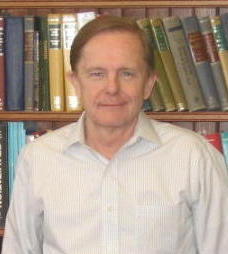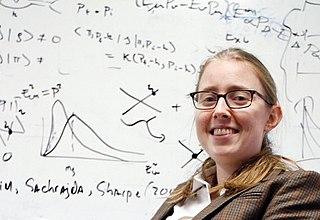
Kenneth Geddes "Ken" Wilson was an American theoretical physicist and a pioneer in leveraging computers for studying particle physics. He was awarded the 1982 Nobel Prize in Physics for his work on phase transitions—illuminating the subtle essence of phenomena like melting ice and emerging magnetism. It was embodied in his fundamental work on the renormalization group.

The Institute for Theoretical and Experimental Physics is a multi-disciplinary research center located in Moscow, Russia. ITEP carries out research in the fields of theoretical and mathematical physics, astrophysics, high energy particle physics, nuclear physics, plasma physics, solid state physics, nanotechnology, reactor and accelerator physics, medical physics, and computer science. ITEP also maintains an extensive educational program and organizes physics schools for scholars and undergraduates. The institute is located near the corner of the Sevastopol prospect and the Nachimowski prospect and occupies part of the former estate "Cheryomushki-Znamenskoye" - an 18th-century manor that is a monument of architecture and landscape art of the 18th-19th centuries.

Gerardus (Gerard) ’t Hooft is a Dutch theoretical physicist and professor at Utrecht University, the Netherlands. He shared the 1999 Nobel Prize in Physics with his thesis advisor Martinus J. G. Veltman "for elucidating the quantum structure of electroweak interactions".

David Jonathan Gross is an American theoretical physicist and string theorist. Along with Frank Wilczek and David Politzer, he was awarded the 2004 Nobel Prize in Physics for their discovery of asymptotic freedom. Gross is the Chancellor's Chair Professor of Theoretical Physics at the Kavli Institute for Theoretical Physics (KITP) of the University of California, Santa Barbara (UCSB), and was formerly the KITP director and holder of their Frederick W. Gluck Chair in Theoretical Physics. He is also a faculty member in the UCSB Physics Department and is affiliated with the Institute for Quantum Studies at Chapman University in California. He is a foreign member of the Chinese Academy of Sciences.
Michael Edward Peskin is an American theoretical physicist. He is currently a professor in the theory group at the SLAC National Accelerator Laboratory.
The MIT Center for Theoretical Physics (CTP) is the hub of theoretical nuclear physics, particle physics, and quantum information research at MIT. It is a subdivision of MIT Laboratory for Nuclear Science and Department of Physics.

David B. Kaplan is an American physicist. He is a professor of physics at the University of Washington, where he was director of the Institute for Nuclear Theory during the period 2006–2016 and is now a senior fellow.

William Allan Bardeen is an American theoretical physicist who worked at the Fermi National Accelerator Laboratory. He is renowned for his foundational work on the chiral anomaly, the Yang-Mills and gravitational anomalies, the development of quantum chromodynamics and the scheme frequently used in perturbative analysis of experimentally observable processes such as deep inelastic scattering, high energy collisions and flavor changing processes.
Christine Tullis Hunter Davies is a professor of physics at the University of Glasgow.
Michael John Creutz is an American theoretical physicist at Brookhaven National Laboratory specializing in lattice gauge theory and computational physics.

Thomas William Appelquist is a theoretical particle physicist who is the Eugene Higgins Professor of Physics at Yale University.
Probir Roy is an Indian particle physicist and a former professor at Tata Institute of Fundamental Research. He is also a senior scientist of the Indian National Science Academy at Bose Institute and a former Raja Ramanna fellow of Department of Atomic Energy at Saha Institute of Nuclear Physics.
Lance Jenkins Dixon is an American theoretical particle physicist. He is a professor in the SLAC Theory Group at the Stanford Linear Accelerator Center (SLAC) at Stanford University.
John William Negele is an American theoretical nuclear physicist.
John Dirk Walecka, often quoted as J. Dirk Walecka is an American theoretical nuclear and particle physicist. He is a fellow of the American Physical Society and the author of numerous textbooks in physics. Walecka is currently the Governor's Distinguished CEBAF Professor of Physics, Emeritus at the College of William and Mary.

Phiala Elisabeth Shanahan is an Australian theoretical physicist who lives and works in the United States. She is known for her work on the structure and interactions of hadrons and nuclei and her innovative use of machine learning techniques in lattice quantum field theory calculations.
Iain William Stewart is a Canadian-American theoretical nuclear and particle physicist at the Massachusetts Institute of Technology, where he is the Otto and Jane Morningstar Professor of Science and the current Director of the MIT Center for Theoretical Physics (CTP). He is best known for his work on effective field theories and for developing the Soft Collinear Effective Theory (SCET).
Zoltan Fodor is a Hungarian-German theoretical particle physicist, best known for his works in lattice QCD by numerically solving the theory of the strong interactions.
Adam Leibovich is an American theoretical physicist. He is a full professor and the Betty J. and Ralph E. Bailey Dean of the Kenneth P. Dietrich School of Arts and Sciences and the College of General Studies at the University of Pittsburgh. His research is primarily in quantum chromodynamics (QCD) and the application of effective field theory to problems of hadronic physics, particularly particles containing one or more heavy quarks. Leibovich also has worked on gravitational wave physics. He was elected a fellow of the American Physical Society in 2017 and a fellow of the American Association for the Advancement of Science in 2018.

Gary Shiu is a Chinese-American theoretical physicist who is a professor of physics at the University of Wisconsin-Madison. His research spans cosmology, particle physics, and string theory. He has made significant contributions to both fundamental and phenomenological aspects of string theory. He is well known for his work in constructing models of particle physics and cosmology from string theory, and in elucidating experimental and observational consequences of fundamental physics. He brought string theory research to the University of Wisconsin-Madison and was involved in the founding of the Theoretical and Computational Cosmology Group and the AI ∩ Universe Initiative.









